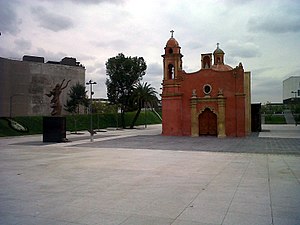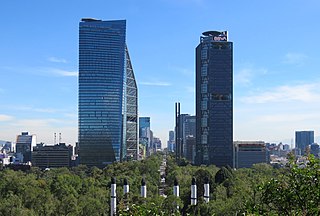
Paseo de la Reforma is a wide avenue that runs diagonally across the heart of Mexico City. It was designed at the behest of Emperor Maximilian by Ferdinand von Rosenzweig during the era of the Second Mexican Empire and modeled after the great boulevards of Europe, such as the Ringstraße in Vienna and the Champs-Élysées in Paris. The planned grand avenue was to link the National Palace with the imperial residence, Chapultepec Castle, which was then on the southwestern edge of town. The project was originally named Paseo de la Emperatriz in honor of Maximilian's consort Empress Carlota. After the fall of the Empire and Maximilian's subsequent execution, the Restored Republic renamed the Paseo in honor of the La Reforma.

Coyoacán is a borough in Mexico City. The former village is now the borough's "historic center". The name comes from Nahuatl and most likely means "place of coyotes", when the Aztecs named a pre-Hispanic village on the southern shore of Lake Texcoco dominated by the Tepanec people. Against Aztec domination, these people welcomed Hernán Cortés and the Spanish, who used the area as a headquarters during the Spanish conquest of the Aztec Empire and made it the first capital of New Spain between 1521 and 1523.

Cuauhtémoc, named after the former Aztec leader, is a borough of Mexico City. It contains the oldest parts of the entity, extending over what was the entire urban core in the 1920s.

Fray Servando is a metro station along Line 4 of the Mexico City Metro. It is located in the Venustiano Carranza borough of Mexico City.

The Macroplaza or La Gran Plaza is a town square or plaza located in the heart of the city of Monterrey, Mexico.
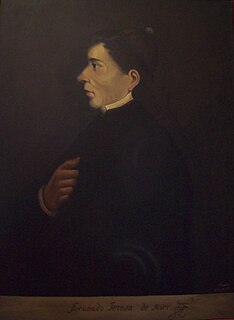
Fray José Servando Teresa de Mier Noriega y Guerra was a Roman Catholic priest, preacher, and politician in New Spain. He was imprisoned several times for his controversial beliefs, and lived in exile in Spain, France and England. His sermons and writings presented revisionist theological and historical opinions that supported republicanism. Mier worked with Francisco Javier Mina during the Mexican War of Independence and, as a deputy in independent Mexico's constituent Congress, opposed Agustín de Iturbide's claim to imperial rule. He is honored for his role in Mexican independence.

The historic center of Mexico City, also known as the Centro or Centro Histórico, is the central neighborhood in Mexico City, Mexico, focused on Zócalo or main plaza and extending in all directions for a number of blocks, with its farthest extent being west to the Alameda Central. The Zocalo is the largest plaza in Latin America. It can hold up to nearly 100,000 people.

The Padre Mier Station is a station on Line 2 of the Monterrey Metro. It is located in the intersection of Padre Mier street and Juarez Avenue in the Monterrey centre. The station was opened on 30 November 1994 as part of the inaugural section of Line 2, between General Anaya and Zaragoza.
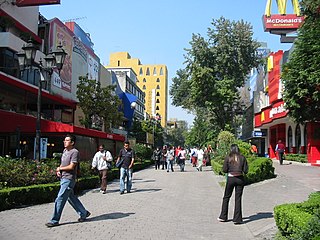
Colonia Juárez is one of the better–known neighborhoods or colonias in the Cuauhtémoc borough of Mexico City. The neighborhood is shaped like a long triangle with the boundaries: Paseo de la Reforma on the north, Avenida Chapultepec on the south, and Eje 1 Poniente on the east.
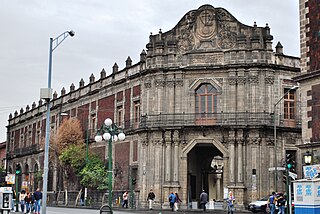
The Palace of the Inquisition stands on the corner of República de Brasil and República de Venezuela streets in Mexico City, Mexico. As neither side of the building faces Santo Domingo Plaza, the entrance is placed at a canted corner to face the plaza. Its long association with the Inquisition, which ended during the Mexican War of Independence, made it difficult to convert to other purposes. However, it eventually became the School of Medicine for the reconstructed National University. When UNAM moved to the Ciudad Universitaria in the 1950s, it retained ownership of this building, eventually converting the structure in what is today the Museum of Mexican Medicine.

The Conjunto Urbano Nonoalco Tlatelolco is the largest apartment complex in Mexico, and second largest in North America, after New York's Co-op City. The complex is located in the Cuauhtémoc borough of Mexico City. It was built in the 1960s by architect Mario Pani. Originally, the complex had 102 apartment buildings, with its own schools, hospitals, stores and more, to make it a city within a city. It was also created to be a kind of human habitat and includes artwork such as murals and green spaces such as the Santiago Tlatelolco Garden. Today, the complex is smaller than it was and in a state of deterioration, mostly due to the effects and after effects of the 1985 Mexico City earthquake. This quake caused the immediate collapse of the Nuevo León building with others being demolished in the months afterwards. Further earthquakes in 1993 caused the condemnation of more buildings. In addition to the lost buildings, many residents eventually undersold or abandoned their apartments, as repairs were either never made or made poorly.
Colonia Esperanza is a small colonia or neighborhood located in the Cuauhtémoc borough of Mexico City just southeast of the historic center. Its borders are defined by the following streets: Lorenzo Boturini to the south, Fray Servando Teresa de Mier to the north, Calzada de la Viga Canal to the east and Francisco Javier Clavijero to the west.

Colonia San Rafael is a colonia of the Cuauhtémoc borough of Mexico City, just west of the historic city center. It was established in the late 19th century as one of the first formal neighborhoods outside of the city center and initially catered to the wealthy of the Porfirio Díaz era. These early residents built large mansions, many with French influence, and many still remain. Middle class residents moved in soon afterwards, and building and rebuilding over the 20th century has introduced a number of architectural styles. These buildings include some of the first works by Luis Barragán and today 383 are classified as having historic value.

Colonia Tabacalera is a colonia or neighborhood in the Cuauhtémoc borough of Mexico City, on the western border of the city's historic center. It was created in the late 19th century along with other nearby colonias such as Colonia San Rafael and Colonia Santa María la Ribera. From the early 1900s, it became a mixture of mansions and apartment buildings, with major constructions such as the now Monument to the Revolution and the El Moro skyscraper built in the first half of the century. By the 1950s, the area had a bohemian reputation with writers, artists, and exiles living there. These included Fidel Castro and Ernesto “Che” Guevara, who met each other and began planning the Cuban Revolution there. Today, the colonia is in decline with problems such as prostitution, crime, street vending and traffic. However, the area is still home to some of the many traditional Mexican cantinas that populated it in its heyday.
Colonia Tránsito is a colonia or neighborhood in the Cuauhtémoc borough of Mexico City, just south of the city's historic center. It is a residential area although there has been recent redevelopment for more commercial uses. It contains two colonial era churches, a number of buildings containing public offices and it is the home of soft drink maker Pascual Boing.

La Lagunilla Market is a traditional public market in Mexico City, located about ten blocks north of the city's main plaza, in a neighborhood called La Lagunilla. The market is one of the largest in the city and consists of three sections: one for clothing, one for furniture and one for foodstuffs, mostly selling to lower income customers. The market is surrounded by small stores and street vendors, many specializing in furniture and dresses and other needs for formal occasions. On Sundays, the number of street vendors grows significantly, a weekly “tianguis” market called a baratillo which traditionally sells used items. One section of this baratillo has developed into a market for antiques, which has attracted higher income customers and even famous ones such as Carlos Monsiváis.

La Merced is a barrio or a neighborhood of Mexico City defined by its socioeconomics and history rather than by an official designation. It extends over the southeast of the historic center of Mexico City and is one of the oldest sections of the city, established over 700 years ago by the Mexica as part of the founding of Tenochtitlan. Over its history the area was associated with commerce, first as a major docking area for boats bringing goods to Tenochtitlan/Mexico City on Lake Texcoco, later via canals as the lake was slowly drained. In the latter 19th century, the La Merced market was established in the area replacing the massive La Merced monastery which was almost completely destroyed in the 1860s. This market was established to centralize the marketing of foodstuffs for the city on one area. The first La Merced market was built in 1890 and then replaced by the current building in 1957, one of the largest traditional Mexican markets in Mexico City. In the 1980s, the wholesale function of this market was taken over by the newly constructed Centro de Abasto in the south of the city, with the barrio then going into economic and social decline, with the area having problems with poverty, prostitution and population loss. Although there have been efforts to revitalize the area and the La Merced market remains important.

The Circuito Interior Bicentenario or more commonly, Circuito Interior or even more simply Circuito, is a 42-km-long urban freeway and at-grade boulevard, forming a loop around the central neighborhoods of Mexico City. It was built starting in 1961. The Circuito Interior received the appellation Bicentenario (Bicentennial) after a renovation that took place in 2010, Mexico's bicentennial year.

The veneration of Judas Thaddaeus in Mexico has taken on importance since the mid 20th century, especially in Mexico City. The center for this veneration is at the San Hipolito Church in the city center, for centuries the only church with any space devoted to this saint. Although the church remains named for its original patron, the image of Judas Thaddaeus has been moved to the main altar. The church and some other locations in Mexico, receive thousands of devotees, mostly coming on the 28th of each month, especially October 28, the saint's feast day. The saint is officially associated with difficult circumstances, but more recently has been associated with delinquents, with the idea that the saint hears the petitions of both the good and the bad. Mexico City, especially its poorer areas, is filled with thousands of street shrines to San Judas Tadeo. Other areas with significant numbers of devotees include Michoacán, the State of Mexico, Mexicali and Monterrey.

The presence of street vendors in Mexico City dates back to pre-Hispanic era and over the centuries the government has struggled to control it, with most recently a clearing of downtown streets of vendors in 2007, but despite this there is a persistent presence of many thousands illegally. Even after oscillating between the realms of legality and illegality, street vending in Mexico and even in other parts of the world, is not the exception but rather has been a norm when it comes to commercial activities. In 2003, it was estimated that there were 199,328 street vendors in Mexico City.
